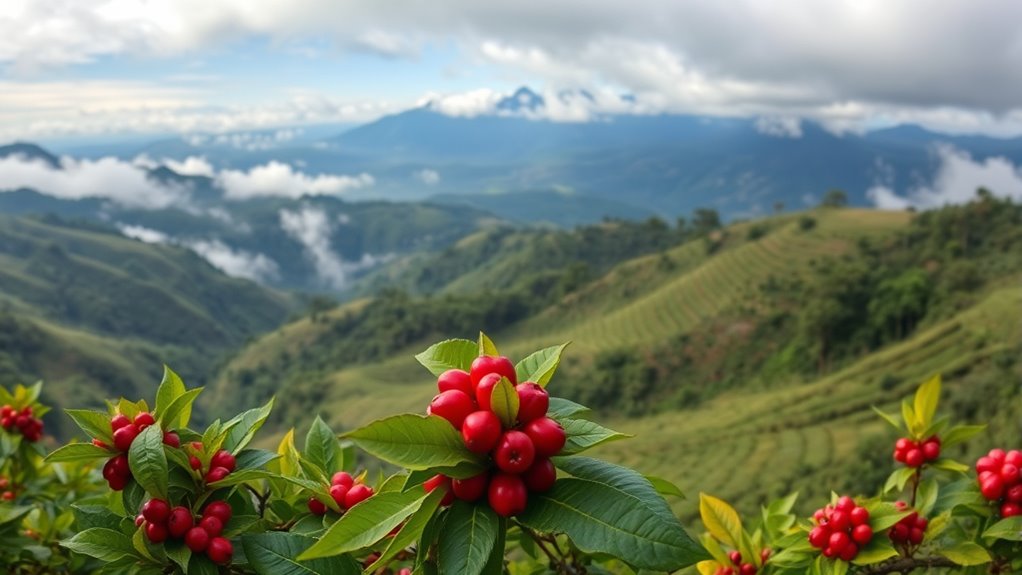Explore Colombia’s top coffee regions—Huila, Nariño, and Antioquia—where lush plantations grow high-quality beans using sustainable, traditional methods. You’ll see how local farms prioritize eco-friendly practices, water conservation, and organic fertilizers to protect the land for future generations. Experience immersive farm visits, taste nuanced flavors, and learn how microclimates influence each cup. Keep exploring to uncover more about Colombia’s vibrant coffee heritage and the passionate farmers behind it.
Key Takeaways
- Huila, Nariño, and Antioquia are renowned Colombian coffee regions known for high-quality, flavor-rich beans influenced by unique microclimates.
- Sustainable farming practices in these regions include organic fertilizers, water conservation, and eco-friendly pest control.
- Coffee tourism offers guided farm visits, tasting sessions, and hands-on experiences, deepening understanding of local coffee culture.
- Local communities emphasize preserving Colombia’s coffee heritage through traditional methods and direct farmer engagement.
- The distinct flavor profiles of coffees from these regions reflect their diverse microclimates and environmentally friendly cultivation methods.

Colombia is renowned worldwide for its exceptional coffee, and exploring this vibrant country’s coffee culture is an enriching experience. When you visit regions like Huila, Nariño, and Antioquia, you’ll quickly realize that sustainability lies at the heart of their coffee production. Many local farms prioritize sustainable practices, ensuring that the environment remains healthy for future generations. You’ll notice how farmers use organic fertilizers, conserve water, and implement eco-friendly pest control methods. These efforts not only protect the land but also produce high-quality beans that carry a unique flavor profile. As you engage in coffee tourism, you’ll have the opportunity to see firsthand how these practices help preserve Colombia’s rich coffee heritage. Visiting a sustainable farm allows you to observe the meticulous attention given to every stage of coffee cultivation, from planting to harvest, all while respecting the environment. Incorporating emotional intelligence into interactions with local farmers can deepen your understanding and appreciation of their dedication to sustainability.
In these regions, coffee tourism offers a chance to go beyond just tasting coffee. You get to immerse yourself in the entire coffee journey—learning about the growing process, the importance of sustainable practices, and how local communities thrive through coffee. Many farms welcome visitors for guided tours, where you’ll walk through lush plantations, learn about the distinct microclimates, and see the traditional methods still used today. This hands-on experience deepens your appreciation for Colombian coffee, emphasizing its cultural significance and the dedication of the farmers. You might even participate in picking cherries or roasting beans, gaining a genuine understanding of what makes Colombian coffee so special.
Furthermore, these regions have developed a vibrant coffee tourism scene, blending education with authentic cultural experiences. Small coffee shops and local markets serve freshly brewed cups, often prepared with beans directly sourced from nearby farms. As you sip, you’ll hear stories from the farmers about their sustainable practices and how they’re working to protect their land. Many tours include tastings that highlight the nuanced flavors derived from different altitudes and processing methods. This direct engagement with local producers fosters a deeper connection to the coffee’s origin and emphasizes the importance of sustainable growth for the industry.
Frequently Asked Questions
Which Region Produces the Most Award-Winning Colombian Coffee?
You’ll find that Nariño produces the most award-winning coffees, thanks to its unique climate and high-altitude farms. This region’s distinct terroir results in exceptional flavor profiles that stand out in regional distinctions and international competitions. If you’re seeking top-tier Colombian coffee, Nariño’s reputation for award-winning coffees makes it a prime choice. Its vibrant, complex beans truly set the standard for quality and excellence in Colombian coffee.
How Does Altitude Affect Coffee Flavor Profiles in Colombia?
Ah, the grand influence of altitude—nature’s way of turning humble beans into a flavor symphony. You’ll find that higher altitudes lead to more nuanced flavor development, adding brightness and complexity to your coffee. The altitude influence slows maturation, allowing beans to develop vibrant acidity and intricate aromas. So, if you crave a sophisticated cup, seek out those high-altitude beans, where elevation truly elevates your coffee experience.
Are There Sustainable Coffee Farming Practices in Huila, Nariño, and Antioquia?
You’ll find sustainable farming and eco-friendly practices are common in Huila, Nariño, and Antioquia. Farmers often use organic methods, water conservation, and shade-grown techniques to protect the environment. They focus on preserving biodiversity and reducing chemical use, ensuring long-term productivity. By supporting these practices, you help promote eco-conscious coffee, which benefits local communities and the planet, making your coffee experience more responsible and sustainable.
What Are the Best Times of Year to Visit Colombian Coffee Farms?
Visiting Colombian coffee farms is like catching the perfect wave—timing matters. The best visiting seasons are during the coffee harvest times, from December to March and June to September. During these months, you’ll see vibrant coffee cherries and lively farm activities. Plan your trip around these peak periods to experience the full flavor of coffee cultivation and witness the hard work behind every cup.
How Can Travelers Participate in Colombian Coffee Tours Responsibly?
You can participate in Colombian coffee tours responsibly by choosing those that prioritize ethical tourism and community involvement. Support local cooperatives and small producers, ensuring your visit benefits the community directly. Be respectful of local customs, avoid disrupting farm routines, and opt for tours that emphasize sustainability. By doing so, you help promote ethical tourism, preserve the environment, and contribute positively to the livelihoods of those who grow your coffee.
Conclusion
Now that you’ve discovered Colombia’s vibrant coffee regions like Huila, Nariño, and Antioquia, you’re ready to appreciate each flavorful cup. Did you know that Colombia ranks as the third-largest coffee producer worldwide, with over 500,000 coffee farmers? That’s millions of hands shaping every bean. So next time you sip your coffee, remember the rich history and passionate farmers behind it. Your simple pleasure is truly a global masterpiece worth celebrating.









